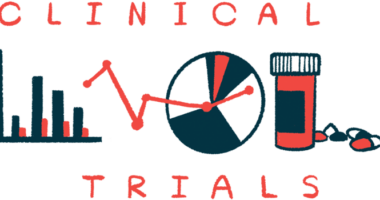Fordadistrogene movaparvovec for Duchenne muscular dystrophy
Last updated Aug. 2, 2024, by Marisa Wexler, MS

What is fordadistrogene movaparvovec for Duchenne muscular dystrophy?
Fordadistrogene movaparvovec is an investigational gene therapy for Duchenne muscular dystrophy (DMD) that was being developed to help patients produce the dystrophin protein they’re lacking, and through that slow or stop muscle degeneration.
Developed by Pfizer, the therapy was being given in clinical trials as a single infusion into the vein, or intravenously, but the company announced in 2024 that it was discontinuing the development of fordadistrogene movaparvovec.
The news followed the reported negative results of the CIFFREO Phase 3 trial in boys who are able to walk.
A number of clinical trials were testing the gene therapy, but dosing in them had been halted in May 2024 following the death of a boy.
Therapy snapshot
| Treatment name: | Fordadistrogene movaparvovec |
| Administration: | One-time intravenous infusion |
| Clinical testing: | Development has been stopped |
How does fordadistrogene movaparvovec work?
DMD, the most common type of muscular dystrophy, is caused by mutations in the DMD gene, which provides instructions to make the protein dystrophin, which supports muscle cells as they stretch and contract with motion.
People with Duchenne typically have no functional dystrophin, resulting in muscle cell damage and death.
Formerly PF-06939926, fordadistrogene movaparvovec used a modified virus, known as adeno-associated virus serotype 9 (AAV9), to deliver a modified version of dystrophin to muscle cells.
Because the DMD gene is too long to fit into the adenoviral vector — DMD is the largest known human gene with 79 protein-coding regions known as exons — a shorter, but still functional version of it was used for the therapy. This version codes for a so-called mini-dystrophin protein that can also retain muscle function.
By providing a source of a working mini-dystrophin to muscle tissue, the treatment was expected to slow or stop muscle degeneration in people with DMD.
How was fordadistrogene movaparvovec administered in DMD?
Fordadistrogene movaparvovec was developed to be administered via a one-time intravenous infusion. In a Phase 1b trial, most participants were treated at a dose of 200 trillion vector genomes per kilogram of body weight (vg/kg). One vector genome is basically one individual AAV9 virus vector carrying a single copy of the therapeutic gene.
This dose was also being tested in other trials.
While patients treated with fordadistrogene movaparvovec in clinical trials will still be monitored over a long term for safety, the gene therapy’s development has been stopped.
Fordadistrogene movaparvovec in clinical trials
Fordadistrogene movaparvovec was first tested in an open-label Phase 1b study (NCT03362502) involving 19 patients, who’ve been monitored for several years after receiving the gene therapy.
Two additional trials then followed: the CIFFREO Phase 3 trial (NCT04281485) for boys ages 4-7, and a Phase 2 trial called DAYLIGHT (NCT05429372) for boys ages 2-3.
Although Pfizer decided to stop the gene therapy’s development, the company stated it would monitor all patients treated with fordadistrogene movaparvovec in clinical trials for safety.
Phase 1b study
The Phase 1b trial enrolled 19 boys with DMD, ages 4-12, who were able to walk and were on a stable regimen of corticosteroids. Three were given a low dose of 100 trillion vg/kg, and the other 16 received 200 trillion vg/kg.
The main goal was to assess the safety and tolerability of a single intravenous infusion of fordadistrogene movaparvovec after a year. Secondary goals included safety measures for up to five years and levels of the mini-dystrophin protein in muscle biopsies.
Safety data were generally positive. Three patients had serious adverse events that were related to treatment, including dehydration, acute kidney injury, and low platelet levels. The third serious adverse event prompted changes to the study protocol to include close monitoring of patients after dosing and higher doses of glucocorticoids post-infusion.
While patients had virtually no dystrophin in their muscles at the start of the trial, its levels increased to 22% of normal after two months of dosing and to 40% of normal after a year.
One year after receiving the gene therapy, 74% of patients also had stable or improved NorthStar Ambulatory Assessment (NSAA) scores, where higher scores represent better function. In contrast, only 30% of participants given a placebo during previous clinical trials had stable or improved NSAA scores after a year.
At three years, analyses indicated preserved muscle function and increased muscle volume, especially in younger patients, ages 6-7.
Based on the promising findings, the study was expanded to include DMD patients who had lost the ability to walk.
In late 2021, Pfizer reported the death of a 16-year-old boy given the high dose, which prompted a change in the study’s protocol to require more intensive in-hospital monitoring.
CIFFREO Phase 3 trial
The randomized, placebo-controlled CIFFREO trial enrolled 226 DMD boys, ages 4-7, who were able to walk. The trial launched in late 2020 and recruited participants across 15 countries.
While the trial was initially recruiting patients regardless of their genetic mutations, its protocol was amended in late 2021 to exclude patients with certain mutations after three cases of muscle weakness in the gene therapy’s trials, two of which involved myocarditis, or heart inflammation.
Upon entering the trial, about two-thirds of the participants were assigned a single infusion of fordadistrogene movaparvovec (200 trillion vg/kg) and the remaining received a placebo. In the second year, the placebo group could have received the gene therapy if that was deemed safe. All would then be monitored for five years after treatment with fordadistrogene movaparvovec.
The study’s main outcome measure was changes in NSAA scores at one year after treatment. While enrollment finished in mid-2023 and dosing was completed in the first placebo-controlled portion, dosing was paused in May 2024 at the point where the patients initially assigned to a placebo would have received the gene therapy. This was due to the sudden death of a boy given the gene therapy in the DAYLIGHT trial.
Results released in June 2024 showed CIFFREO didn’t meet its primary and secondary goals. The gene therapy didn’t improve motor function as assessed with NSAA scores and didn’t outperform the placebo in significantly improving the secondary measures 10-meter run/walk velocity (the time taken to complete the test) and time to rise from the floor.
These negative findings prompted Pfizer to stop developing fordadistrogene movaparvovec.
DAYLIGHT Phase 2 trial
The open-label DAYLIGHT study was designed to test fordadistrogene movaparvovec, at a dose of 200 trillion vg/kg, in about 10 boys with DMD, ages 2-3. Participants were enrolled at five sites in Australia and the U.S.
The study’s main goal was to evaluate the therapy’s safety profile in these young children in the first year after gene therapy. Like CIFFREO, enrollment in DAYLIGHT finished in 2023.
In May 2024, Pfizer reported the sudden death of a boy who’d been given the gene therapy in early 2023. The company said it would work with trial investigators to understand what happened and whether the death was related to the gene therapy.
Common side effects of fordadistrogene movaparvovec
To date, detailed safety data of fordadistrogene movaparvovec come only from a Phase 1b clinical trial. Side effects experienced by patients who received the gene therapy included:
- vomiting
- fever
- nausea
- decreased appetite
- fatigue
- headache.
Muscular Dystrophy News Today is strictly a news and information website about the disease. It does not provide medical advice, diagnosis, or treatment. This content is not intended to be a substitute for professional medical advice, diagnosis, or treatment. Always seek the advice of your physician or other qualified health provider with any questions you may have regarding a medical condition. Never disregard professional medical advice or delay in seeking it because of something you have read on this website.
Recent Posts
- Dyne, citing positive trial data, to ask FDA to approve DMD therapy
- My hope for the FSHD community this Advent season
- New trial results highlight gains in arm and heart function for DMD
- Finding the right words to describe our life experiences
- Planning a ‘Krank’ Christmas and getaway with accessibility in mind
Related articles






